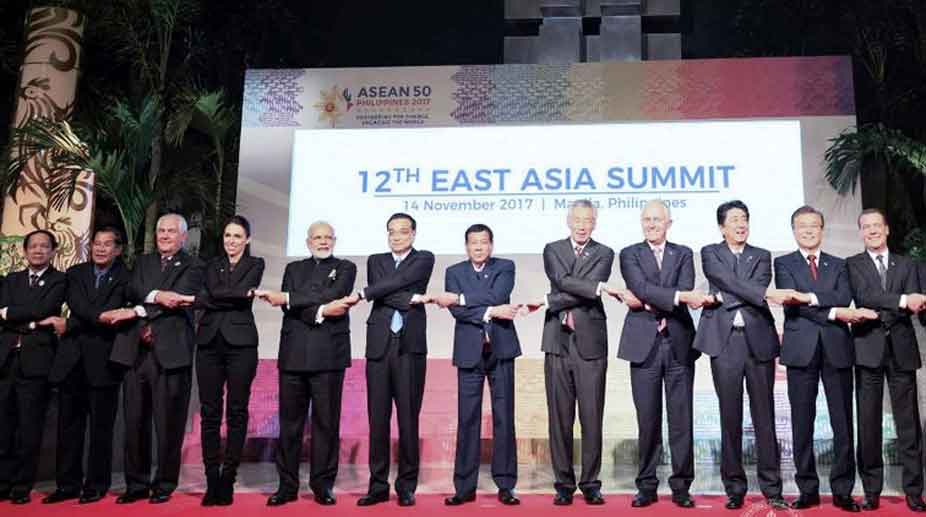President Donald Trump repeatedly used the term ‘Indo-Pacific’ during his 12-day Asian tour, including in his speech at the APEC meeting held at Danang in Vietnam last week. A few days later, senior officials of Australia, India, Japan and the US, meeting on the sidelines of the East Asia Summit in the Philippines, agreed that a “free, open, prosperous and inclusive Indo-Pacific region serves the long-term interests of all countries in the region and of the world at large.”
These developments have led to speculation that the idea of a Quadrilateral Security Dialogue is being revived after a hiatus of ten years. It is expected that this development will lead to strategic realignment for peace and stability in the Indo-Pacific.
The ‘Quad’, as it has come to be called, had a short-lived existence in 1987-88 when Australian Prime Minister Kevin Rudd pulled his country out after China, which perceived the Quad as an attempt to counter its rise, lodged a formal protest with all four countries. Now, in view of increasing Chinese political donations and China’s growing influence in its universities, Australia appears to have had a change of heart.
In this era of strategic uncertainty, the only certainty is that China’s rise is unlikely to be entirely peaceful. China’s brazen violation of international norms in recent years, particularly its construction of military facilities on reclaimed islands in the South China Sea, and its growing military and economic power pose a strategic challenge to the countries in the Indo-Pacific region, including India, the United States and its allies and strategic partners.
China senses the emergence of a security vacuum in the Indo-Pacific and is rushing to fill it ~ all by itself. As part of its strategic outreach, China is rapidly upgrading the capabilities of the PLA Navy. It has discarded Deng Xiaoping’s 24-character strategy to “hide our capacity and bide our time”. It has also stopped using the phrase “peaceful rise” while referring to its military and economic growth.
China’s economic growth, now slowing, has been fairly uneven and non-inclusive. There is a deep sense of resentment against the leadership of the Communist Party for the denial of basic freedoms and rampant corruption. The discontent simmering below the surface could boil over and lead to an uncontrollable spontaneous implosion. David Shambaugh, a well-known China scholar, is the latest to have jumped on to the China-may-implode bandwagon. The sudden collapse of Chinese stock markets in 2015-16 may have provided the first glimpse of impending implosion.
Also, given its recent belligerence, China could behave irresponsibly somewhere in the Indo-Pacific. It could decide to intervene militarily in the South China Sea, or to occupy the Senkaku/ Diaoyu islands or to use force to resolve territorial and boundary disputes. Though President Xi Jinping has denied plans to ‘militarize’ the South China Sea, surely China is not building airstrips there to fly in Japanese tourists.
Both the contingencies have a low probability of occurrence, but will be high impact events with widespread ramifications if either of them comes to pass. The US, which is the leading provider of security in the Indo-Pacific, and India, will need strong partners to deal with the fallout and to manage the consequences. The US-India strategic partnership makes eminent sense as a hedging strategy for both countries.
Though it will be a gradual and long-drawn process, a cooperative security framework may eventually emerge from the discussions now being initiated by the leaders of Quad. Together with the US and its other strategic partners, India must take the lead in working towards the establishment of an architecture to ensure peace and stability in the Indo-Pacific and for the security of the global commons ~ air space, space, cyberspace and the sea-lanes of communication to enable the freedom of navigation and the free flow of trade.
If China is willing to join this security architecture, it should be welcomed. However, the experience has been that China prefers to plough a lonely furrow rather than cooperate with its regional neighbours. Its record in UN peacekeeping operations has belied expectations. China took over five years to join the international anti-piracy operations off the Horn of Africa. Even now the PLA Navy limits its activities to escorting its own merchant ships and does not coordinate operations with the other navies.
The Quad ~ the concert of democracies ~ should be gradually enlarged to include other strategic partners such as Australia, Japan, Singapore, South Korea and Vietnam to realise its true potential as a force for peace and stability in the Indo-Pacific.
Cooperative security does not necessarily require a formal military alliance. Cooperative security entails the sharing of intelligence; joint counter-terrorism and counter-proliferation efforts; upholding the rules and norms governing maritime trade; providing help to the littoral states to meet their security needs; helping to counter piracy, arms smuggling and narcotics trafficking; and, undertaking joint humanitarian and disaster relief (HADR) operations in the region.
India’s area of strategic interest now extends from the South China Sea in the east to the Horn of Africa in the west. In order to discharge its growing responsibilities towards regional security, India must upgrade its military capacities for intervention operations in the Indo-Pacific. Two rapid reaction-cum-air assault divisions backed by air support, air lift and sea transportation and logistics resources for 30 days each will be required by 2025-30. It will then be apparent to potential adversaries that India will not hesitate to intervene in conjunction with its strategic partners if its vital national interests are threatened in its area of strategic interest.
The writer is Distinguished Fellow, Institute for Defence Studies and Analyses (IDSA), New Delhi












